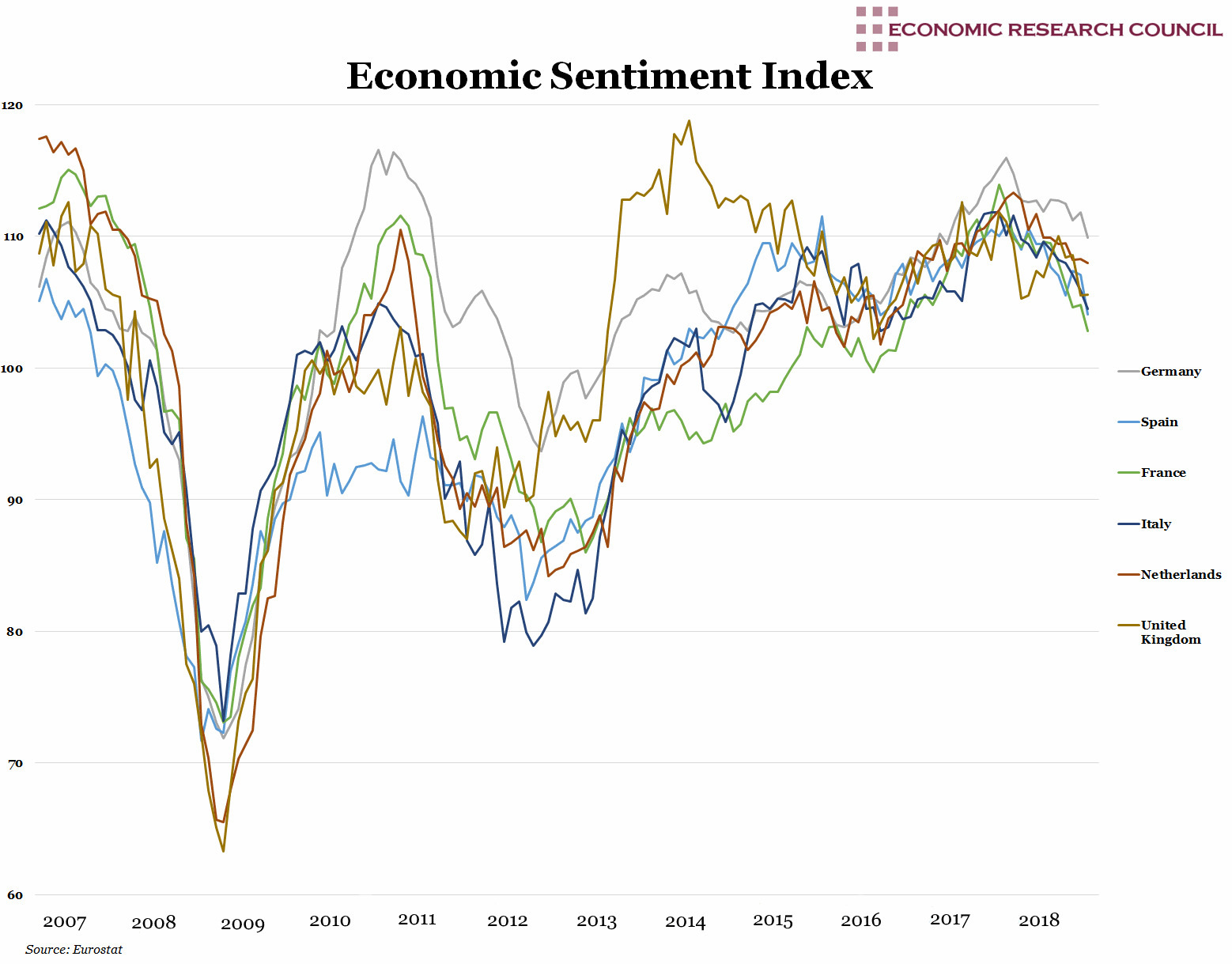
Summary
The development of the index is notable because, over the course of 2018, it has consistently fallen for all EU member states (including the UK). Some have recently speculated that these developments point to an adverse change in the business cycle. Others, including the European Commission, highlight that the index remains at record highs, and maintain, despite its poor recent performance, that is does not necessarily an indicate the onset of an economic downturn. The poor index readings over the past year have been attributed to many causes. Continuing Brexit uncertainty has taken a toll on both sides of the negotiations, with both UK and Eurozone industrial, services, and consumer confidence falling as a result. Retail consumption has been up over the past year, but as it carries a low weight in the index, these increases have not been enough to counter falls in other indices. A fall in the industrial sentiment portion, attributed to eroding productivity and output growth has been of particular note, especially in Germany, the EU’s largest economy and a global manufacturing power. The continued uncertainty over Europe’s trade relations with the United States have also played as a factor in the decline. In Italy, struggles with debt and economic stagnation among increasingly determined government actions to reverse these trends have resulted in poor national and international sentiment about its future. Spain, a holder of significant Italian debt, has seen its index dragged down. Of considerable importance, the European Central Bank halting quantitative easing initiatives in November has hurt sentiment throughout the whole year, especially in the industrial sector due to the potential reduction in the ability to service future debt.
What does the chart show?
The trends show the European Economic Sentiment Index (2007-2018), constructed through the use of survey data by the European Commission. The Index is a weighted measure representing Industry (40%), Services (30%), Consumers (20%), Retail (5%), and Construction (5%).
This index is used in order to forecast economic development, as it indicates the likely path of development throughout each represented demographic. It can be used in this manner because the survey respondents are uniquely suited within their respective demographics to provide information which has not yet played out or been reflected in the real economy. ‘includes information that is known by the survey respondents but not yet reflected in aggregate economic variables’.
Why is the chart interesting?
Despite these developments and decreasing optimism about future prospects of European growth, the European Commission has tempered expectations and pointed out that the index itself remains at an overall high level and other indicators, such as industrial capacity utilisation, remain well above their average level over the life of the Economic Sentiment Index, first produced in 1980. The index itself is not of equal relevance to the nations listed, where the weightings of the different sectors do not accurately reflect all the economies, eg. in Germany manufacturing is of far greater importance than in the UK. The recent sharp decline in the index for France on the chart likely is exacerbated by the sustained civil unrest of the ‘Gilet Jaunes’ protesters.
During the 2008 recession, it is clear that the more reliant on the financial sector the economy (UK and the Netherlands), the more adverse the initial effect of the crisis. The ensuing period of austerity then affected each country differently; with Spain, Italy and the UK experiencing a far slower recovery of confidence than France, the Netherlands and Germany, perhaps due to greater labour market flexibility in the former group of countries. By 2013, UK and US banks had improved their capital to risk-weighted asset ratios to an extent satisfactory for the slow increasing of lending, thereby bolstering business investment in the UK. To some extent this may account for the UK’s outperformance of other EU economies in the period between 2013 and 2016. From 2016 onwards, the reduction in the value of sterling appears to have fallen short of boosting confidence in the UK in the face of Brexit uncertainty. Despite the uncertainty, confidence in the UK economy appears to be stronger than Italy, Spain and France as we move into 2019.
Week 2, 2019

